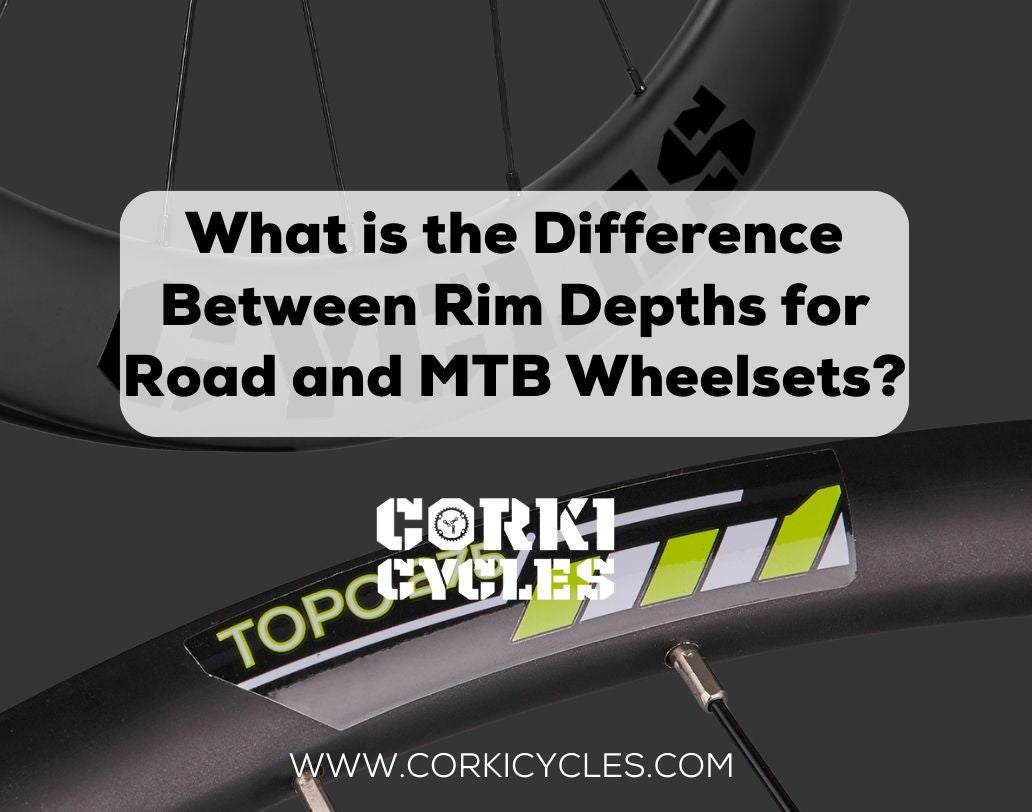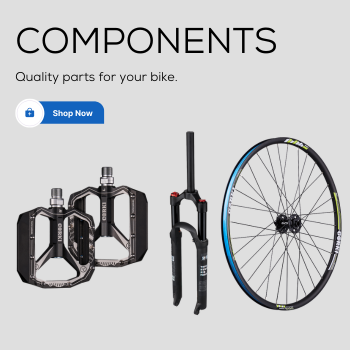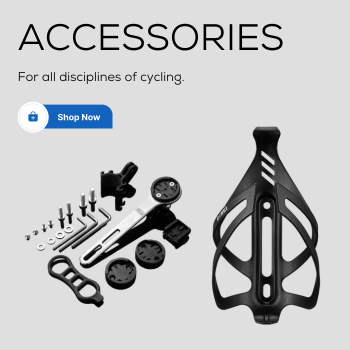
Cycling isn't just about pedals and handlebars. It's a world where even the tiniest details can make a big difference. One such detail is the depth of the rims on your bike's wheels. Whether you're cruising on smooth roads or tackling bumpy trails, the depth of your wheel rims matters.
In this exploration, we dive into the difference between rim depths for Road and MTB wheelsets. And reveals how these differences cater to the needs of each type of rider.
Road and mountain bike wheels have different rim depths because they're made for different types of riding. Each type of riding needs wheels that work well for its own kind of terrain. Let's explore these differences:
Road Bike Rim Depths
Road bikes typically have a wider range of wheelset depths than mountain bikes. Deciding how deep to make road bike wheels depends on what the rider likes and how they ride. It also depends on the kind of cycling they do. Here is a general breakdown of the wheelset depths used on road bikes:

Low to Medium Profile (20mm - 50mm)
These rims have sizes from 20mm to 50mm. They find a good balance by improving how air flows around them while also keeping the weight low.
- (20mm - 30mm): Embarking on a journey with uphill battles, these wheelsets become your reliable companions. They support you along the way, making the uphill climbs easier. Lower-profile rims, typically in the range of 20mm to 30mm. It is the lightweight heroes that make ascending those challenging hills feel like a breeze. Less weight translates to less effort required during climbs. It makes your road bike the ideal companion for conquering hilly terrains.
- (40mm - 50mm): Picture yourself on a stretch of straight road, craving speed and efficiency. This is where the magic of deeper rims, in the range of 40mm to 50mm, comes into play. These rims elevate your road bike's aerodynamics to another level. It's like giving your bike a set of wings, reducing air resistance and allowing you to maintain higher sustained speeds. Your road bike transforms into a precision instrument for cutting through the air with finesse.
Medium to High Profile (50mm and above)
Road bikes with medium to high-profile rims (50mm and above) are usually made for certain purposes. They are designed for riders who love speed, aerodynamics, and competitive cycling. For example, Aero road bikes, Time trial (TT) bikes, and trial bikes.
Medium to high-profile rims (50mm and above) offer substantial aerodynamic advantages. The increased depth allows cyclists to maintain higher speeds with less effort. Then, turning the bike into a speed machine. The longer the distance, the more energy you save, translating to reduced time. It's like having a built-in speed advantage, perfect for those who crave velocity. Additionally, deep rims enhance the wheel's stiffness. Therefore, it has a more efficient transfer of power from the pedals.
However, there's a trade-off for the benefits of deep rims. The first trade-off involves comfort. The extreme stiffness can make the ride feel hard. It's like sitting on a jackhammer, not a comfy saddle, especially on a time trial machine with its aggressive design. This might be okay for a short ride of about an hour on flat roads. But no pro rider would be happy using very deep rims in a long race like a classic or national stage race. However, when cycling in a triathlon on a straight, level road with calm weather, having an 86mm deep rim becomes a significant advantage.
The second is crosswind challenges. While these rims provide significant aerodynamic benefits, cyclists need to master the delicate balance between aerodynamics and handling. Deep rims perform great when the wind comes straight at them. But when a crosswind hits their wide sides, they act like windmills, pushing the bike sideways and causing trouble with steering. When riders have to struggle to keep the bike going straight, it hurts how well they can ride. The lighter the cyclist, the more tricky this can be.
Mountain Bike Rim Depths
Now, let's shift gears to the rugged world of mountain biking, where the trails are rough, and the bumps are part of the fun. Mountain bike wheelsets have a different story to tell about rim depths.
Mountain bikes (MTBs) typically use wheelsets with lower-profile rims compared to road bikes. The rim depths for MTB wheelsets commonly fall within the range of 15mm to 35mm.

Mountain bike wheelsets, with depths ranging from 15mm to 35mm, are chosen based on the special needs of off-road terrain. Different styles of riding within mountain biking also play a role in this selection. Here are the key reasons for this common range:
Durability and Strength:
Mountain biking takes wheelsets through rough and unpredictable terrains. In these conditions, impacts and stresses are part of the game. Therefore, it needs a wheelset that has good durability. Lower-profile rims (15mm to 25mm) are chosen to prioritize durability and strength. A shallower rim depth provides a more robust structure, capable of withstanding the punishing conditions encountered on off-road trails.
Handling Rough Terrain:
The lower profile of the wheelset enhances its ability to handle rough off-road terrains. A shallower rim has a more forgiving flex. It helps with shock absorption and control on bumpy surfaces. This design contributes to a smoother ride and better handling over uneven terrain. This is crucial for navigating rocky trails, roots, and other obstacles commonly found in mountain biking environments.
Bike Type Considerations:
Different riding types within mountain biking have distinct requirements. It also influences the choice of wheelset depths.
- Cross-Country (XC) Biking: XC bikes are prized for their agility and speed. For this style, selecting lighter rims with depths on the lower end of the scale (15mm to 20mm) is common. This choice prioritizes enhanced acceleration and responsiveness. It is crucial for navigating the dynamic nature of cross-country trails. Opting for a lighter wheel ensures that the bike remains nimble while still being strong enough to handle the demands of off-road terrain, providing a personalized balance for XC enthusiasts seeking both speed and durability.
- Trail and Enduro Biking: Trail and enduro bikes are crafted for versatility, conquering diverse conditions. These bikes with medium-profile rims, typically ranging from 20mm to 25mm. This range offers a personalized blend of strength and weight, ensuring resilience on varied terrains. For trail riders who encounter a mix of challenges, the medium-profile rims provide the durability needed for rocky descents and the agility required for technical climbs. This thoughtful combination caters to the specific demands of trail and enduro biking, delivering a wheelset that adapts seamlessly to the ever-changing landscape. If you're someone who loves the thrill of tackling different terrains, trail and enduro biking with medium-profile rims might be your calling.
- Downhill Biking: Downhill mountain bike wheelsets tend to have deeper rims, with depths ranging from 30mm to 35mm or even more. This selection of higher-profile rims not only enhances the bike's responsiveness but also strikes a personalized balance, offering downhill enthusiasts the strength needed to tackle rugged descents while maintaining the agility necessary for precise and daring maneuvers.
It's crucial to note that these are generalizations, and individual rider preferences can vary. Additionally, advancements in technology and changes in design trends may influence the ideal rim depth for specific applications. Riders should consider factors such as their riding style, terrain preferences, and desired performance characteristics when selecting a mountain bike wheelset.
Weight Considerations:
While strength and durability are paramount in mountain biking, weight remains a crucial factor, too. Lighter rims enhance the bike's overall agility and maneuverability. The 15mm to 25mm range strikes a balance. It provides the necessary strength without compromising the bike's responsiveness.
Versatility:
The 15mm to 25mm range is a versatile choice that caters to a broad spectrum of mountain biking scenarios. It allows riders to enjoy the benefits of durability, strength, and maneuverability across various terrains and disciplines.

In summary, mountain bike wheelsets with depths ranging from 15mm to 25mm strike a careful balance. This balance considers durability, strength, and weight, all tailored to meet the challenges and demands of off-road riding.
Conclusion
In summary, the differences in rim depths for road bikes and MTB wheelsets reflect the nuanced priorities of each discipline. Road biking leans towards the delicate equilibrium of aerodynamics and weight for speed on smooth roads, while mountain biking prioritizes durability and strength to handle the challenges of off-road terrains. The choice of rim depths within each category caters to specific riding scenarios and individual preferences.
So, why does all this matter to you? Well, knowing about rim depths helps you pick the right bike for your adventures. Whether you're zipping through the city on a road bike or tackling mountain trails, the depth of your wheel rims is like your bike's secret weapon. It shapes how you ride and makes your cycling experience a whole lot more awesome. So, next time you hop on your bike, take a moment to appreciate the depths beneath your wheels—they're your ticket to cycling greatness!
Riders, if you have questions or want to share your biking stories, feel free to drop them below. Happy riding!




